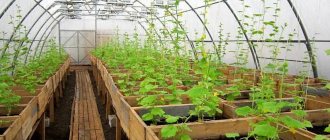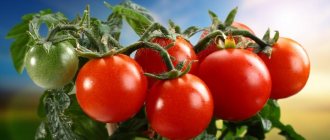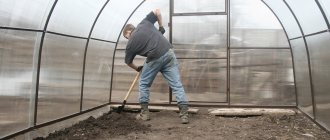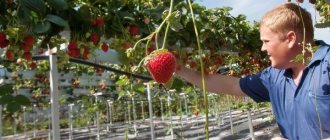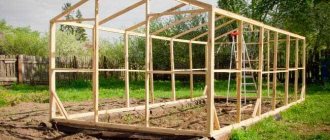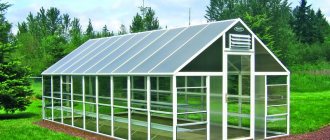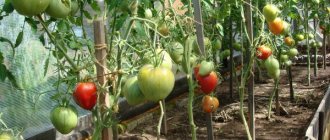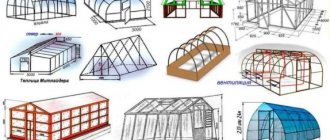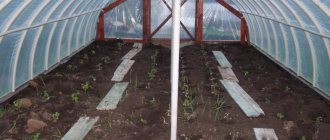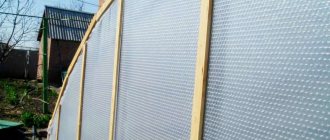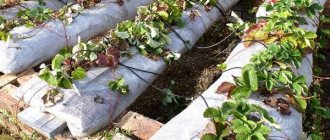Dutch greenhouses are used on an industrial scale and in homestead farming. They are superior to competitors in energy saving, productivity and many other technical and economic indicators.
The durability and reliability of greenhouses developed in the Netherlands is confirmed by their many years of successful operation in Europe and far beyond its borders. These are high-quality designs oriented towards the future, success, stability and good financial results. What is their secret?
Features and characteristics of the Dutch greenhouse
People have long adapted to growing vegetables and fruits in artificially created conditions. Few people know that Dutch greenhouses became a powerful impetus for this.
This became possible thanks to the many advantages of these structures. It is known that today they are most often used in the industrial sector, because they are not suitable for private use.
- A precisely calculated metal frame provides not only reliability of the structure, but also durability. Quite often, as practice shows, large industrial greenhouses have quite a lot of problems due to the drainage of water that accumulates after precipitation.
- To somehow overcome this problem, they invented a gutter made of aluminum. The main difference of this invention is the presence of special glass seals, as well as an installed drain for the resulting condensate.
Even with their elongated shape (about 60 meters), the greenhouses were able to be protected from dripping, which is inherent in greenhouse structures. This was done in order to protect plants from its harmful effects on their growth.
The design of the structure is thought out in such a way that even during heavy rains, water does not get inside the greenhouse, but simply flows down the glass frame.
Complete greenhouse solution
The ALEKON company specializes in the design and construction of turnkey greenhouses and universal greenhouse complexes, using in their work the most modern agrotechnical solutions used in world practice.
We carry out the full range of work related to the management of modern greenhouse farming:
- We develop the concept and initial idea.
- We design industrial complexes.
- We build them on a turnkey basis.
- We put it into operation.
- We supervise or directly manage the production process of growing products.
- We train service personnel at agricultural courses in Israel and directly on site.
Advanced greenhouse complexes and innovative solutions
The complexes built by ALECON are intended to use effective technology for growing a wide range of products - any type of berries, vegetables, green crops, flowers.
All types of plants can be grown in a vegetative-technological cycle shortened by 2-5 times. The production and technological support of greenhouses allows for a year-round production cycle.
Pros and cons of the Dutch greenhouse
The Dutch greenhouse has a number of positive qualities for which it is incredibly highly valued. These include:
- The most accurate calculation of sizes, which is performed using a special CASTA program.
- How much light penetrates into the greenhouse greatly depends on the thickness of the walls; their ratio is one to one.
- The greenhouse comes with anti-hurricane latches, which save the greenhouse structure from deformation during strong winds.
This is the main list of advantages that Dutch greenhouses have in contrast to the main ones. During their operation, no negative qualities were observed in these structures, which makes them even more in demand.
Important nuances of coverage
Advantages of covering Dutch greenhouses
The main advantages of float glass coating, made using a fundamentally new method of pouring into molds, are:
- Light transmission capacity of 90%, increases productivity.
- Convenient fastening.
- Excellent insulating properties.
- Uniform density over the entire surface.
- Durability.
Attention!!! For the manufacture of curtain systems, the material is selected depending on regional climatic conditions and the type of crops grown. The use of the modern “Smart-Slip” system ensures maximum and uniform fixation of the profile, tight fit to the truss, helping to save heat.
Dutch greenhouse frame
To make the frame of a Dutch greenhouse, either steel or aluminum is most often used.
The quality of a steel structure is primarily affected not only by the thickness of the metal itself, but also by how accurately and correctly all the necessary calculations were made regarding the ratio of the metal container and the percentage of lighting that can penetrate the room.
Aluminum structures are used to build Venlo greenhouse models. Today it is one of the most modern modifications in the world. It has a number of factors:
- The products have been used for several years, so they have enormous experience in growing vegetables;
- They are constantly improving; significant funds are allocated for this;
- They have EU certification, for which they must meet strict requirements.
All this data suggests that Dutch greenhouses are high-quality, reliable and widely in demand structures.
What should you pay attention to?
Having decided on the choice of materials, pay attention to several nuances. This will allow you to make the right choice
- Size matters. A structure with insufficient height lacks air. It is difficult to care for tall plants and stand up to their full height.
- The size of the entrance door must be sufficient for the user. In order for water and snow to drain from the slope, its angle of inclination must be at least 30 degrees. The shape of the slope is especially important.
- It is better to build a building in the form of a house with a removable roof. This is thought out at the greenhouse design stage. The sliding roof will allow you to ventilate it at any time convenient for you.
Dutch greenhouse cladding
In order to give the structure strength, a special coating is used - float glass. To ensure that the coating is of high quality and durable, the latest special filling technology is used to create it.
Thanks to this technique, glass becomes:
- Light-transmitting. The level of light that penetrates through the glass reaches 90 percent. Thanks to this, the yield doubles.
- Ease of installation. Thanks to the tolerances on each side of the structure, glass can be fixed easily and simply.
- Durable and highly insulating material allows the greenhouse to serve for a long time and with high quality.
- High product density. It is these qualities that help the greenhouse withstand the load from snowdrifts and strong winds.
Which is better?
Having decided to build a greenhouse as a house, users think about which one to choose so that the structure lasts as long as possible.
There are basic selection criteria.
First decide on the frame material. Choose between metal and wood. Remember that the tree will periodically have to be coated with a composition against rotting and insects. When choosing a coating, you should take a closer look at polycarbonate. It is highly rated by professional craftsmen, which is a good indicator. Choose a reinforced version (with reinforcement of facades and arches). He will not be harmed in case of bad weather
Pay attention to the presence of windows. Glass is problematic in construction and will create a significant weight load on the frame. However, as a coating material it is a good solution. Choose an option in which you can build an automatic watering system and thermal drive
The polyethylene variety cannot be heated.
Ventilation in a Dutch greenhouse
Dutch greenhouses are equipped with an excellent ventilation system, despite its height, six meters, and the presence of frames for ventilation.
After all, even if the transom is not fully open, ventilation will be carried out many times faster and better than in a low structure, but with completely open frames.
The speed of movement of air masses in low greenhouses decreases due to plants, and this in turn leads to the fact that their heat exchange deteriorates. In high greenhouses, plants do not interfere with the movement of air masses.
Advantages of greenhouse farming
Our industrial greenhouses are in great and steady demand among buyers. Their advantages in comparison with similar products from other manufacturers are obvious. They are as follows.
- High agrotechnical characteristics of greenhouses and automatic control of the growing process make it possible to obtain record yields. For example, our benchmark indicators (per 1 hectare daily) are as follows: for lettuce - up to 2.5 tons, for strawberries - up to 0.65 tons. The latter indicator is ensured by using the latest technology for growing strawberries. And the figures given are not the limit. They can be improved by introducing additional automation and increasing the area of greenhouses.
- The moderate cost of our glass and polycarbonate complexes allows us to ensure high production profitability. The price of construction depends on the geographic location of the greenhouses, local conditions and the chosen technology. Dutch greenhouses cost buyers 20-40% more. But cheap Chinese and Russian ones cannot compete with ours in terms of design reliability and yield level.
- The high level of automation makes it possible to operate with a workforce starting from 5 people per 1 hectare of production area.
- When constructing complexes using our technologies, it ensures the preservation of the top fertile layer. He packs up and moves to another place.
- The use of polycarbonate as a covering material significantly reduces construction costs - in comparison, for example, with the construction of glass Dutch greenhouses. Growing in polycarbonate complexes has other advantages. This modern material is durable (has a 10-20 year guarantee), is 40% lighter than glass, and has transmittance to the most useful part of the sunlight spectrum. You can read more about the characteristics of polycarbonate here.
- ALEKON complexes allow you to grow several crops simultaneously in the same greenhouse. The latter is divided into separate sections by transparent partitions, creating an individual microclimate in each zone, necessary for a specific crop, and preventing the migration of pests and infections. A variety of combinations of crops and timing of their cultivation are possible. Harvesting one crop may be combined with planting another. Greenhouse farming based on this principle makes it possible to quickly change the composition of crops in the greenhouse, quickly responding to current market demands.
- The use of forced ventilation and light and heat shields allows you to create optimal growing conditions.
- Depending on local climatic conditions, optimal thermal insulation methods are selected to ensure maximum energy savings. Solutions for the latter are based on the company's own developments.
- The implementation of a closed cycle of nutrients and water consumption ensures economical use of water and nutritional components.
The ALEKON company has 20 years of experience in building greenhouses in a wide variety of climatic conditions. Our complexes are operated in Israel, Italy, Spain and Russia. We have built and managed polycarbonate greenhouses in Kazakhstan (Astana), where the most modern Israeli technologies were used. For two years now, our complexes have been successfully operating in extreme weather conditions, where temperatures can vary from -50 to +50 °C. More detailed information about the Kazakhstan greenhouse project can be found here.
We use the latest growing technologies using our own developments. Our experience allows us to effectively carry out the entire range of work, including personnel training and direct operation of greenhouse complexes.
Practical conference “growing strawberries and greenhouse business - Agro-Business 2017”
— the organizer of the Agro-Business 2022 conference invites specialists to Israel to a practical conference on strawberries and greenhouse business. Agro-Business 2017 is the only event in Russian that provides an opportunity to get answers to all questions related to strawberry cultivation, irrigation, irrigation and growing strawberries in greenhouses. At Agro-Business 2017, Russian -speaking specialists will become familiar with advanced Israeli technologies and receive practical advice on the topic of crop production.
For detailed information about the Agro-Business 2017 conference
Organization of watering in a greenhouse
In these structures, the irrigation system is automated. You don’t need to do anything for this, since all work on assembling and installing the system is carried out directly during the production process.
- The greenhouse is delivered to the client fully assembled.
- The irrigation system is controlled directly through the computer.
This condition allows you to create a normal microclimate for growing a good crop.
Life support systems
Heating
Modern greenhouses in Holland have a heating system based on the “Tichelman Principle”. This allows you to create the same temperature regime at any point in the structure.
Features of the method:
- accurate calculation of the location and number of heating pipes;
- adaptation to existing heat sources, for example, to an external boiler room or an underground heat source using a heat exchanger, while saving coolant.
Advice: carefully select a company that can correctly calculate the heating system for a Dutch greenhouse. Income from growing plants will directly depend on this.
A modern greenhouse heating system should also be equipped with an external storage tank for hot water. This will prolong the operation of the boiler and help save resources. Remember - heating must be calculated taking into account the wishes of the customer and the local climate.
READ ALSO: How to choose a diamond wheel for tiles
Watering
The basis of any Dutch greenhouse technology is climate control and irrigation automation. The main thing here is the greenhouse computer. The greatest preference throughout the world is given to Hoogendoorn equipment, which serves for many decades, protecting against any troubles.
Watering
It is difficult to imagine today the control of irrigation and microclimate without an “electronic brain” that reacts in a split second to changes in the environment. Skillful use of a computer can significantly save time and resources. A short training and instructions for the equipment allow you to achieve the desired result.
Interesting solution
Using the Internet, it is possible to monitor the condition of the greenhouse in Holland and abroad. The system allows you to quickly solve problems and saves the client money.
Additional shading for the greenhouse
This function is used in greenhouses with single glazing and consists of specially vertically moving screens. Their opening and closing is carried out using a special control mechanism.
These curtains are installed around the entire perimeter of the product in order to control the amount of light entering the greenhouse. In addition, they can act as additional heat insulators.
Growing process: main stages
Since Dutch cultivation of tomatoes in a greenhouse involves year-round cultivation, the periods of explantation of seedlings will vary in time. So, in the hot summer season, seedlings are grown for thirty-five to forty days, in the spring season - for 45-50 days, winter growing of young greenery will take 55-60 days.
To sow seed material in the greenhouse, you need to set aside a well-lit, ventilated and warm place. Seeds can be planted either in the ground or in special cassettes filled with drainage material. The seeds are planted in a nutritious soil substrate, which consists of sand and peat compost, thoroughly until the disinfected seed is added.
Step-by-step instructions for planting tomato seeds:
- Drainage (expanded clay or coarse sand) is placed at the bottom of the cup-pot, then soil is poured (it is moistened abundantly before planting).
- A hole about two centimeters deep is made in the container, into which the seeds are poured (about five pieces in each pot).
- The sowing is covered with a layer of wet sand (the seeds are covered one and a half to two centimeters).
- To better retain moisture and encourage seeds to grow, the planting container is covered with a transparent film. Pots should be placed away from bright light.
In a greenhouse, seed germination will be rapid, and after ten to twelve days the seedlings can be transplanted into containers, where they will grow continuously.
Young seedlings are moved extremely carefully, shaking them off the earthen substrate, so as not to damage or break the root shoots. Containers filled with special mineral wool are placed on the beds inside the greenhouse so that watering pipes can be laid at the roots of the tomatoes.
The optimal location of containers with tomatoes: with an interval of about fifty centimeters from each other, so that the distance between the bushes is about seventy centimeters, and the width of the paths is about a meter. This will ensure ease of care for the plantings, and will also allow the plants not to suffer from a lack of sunlight and stagnant air.
Even at the initial stage, you can understand whether the vegetative development of tomatoes is going well. The bushes should have average thickness of stems (not thin, but not powerful) and even, bright leaves. No more than ten leaves should be formed on a tomato flower cluster. The brush itself should have a neat, regular shape and grow downward. Pedicels should be short, dense, internodes should be staggered. It is these indicators that hint at the possibility of getting an excellent harvest.
Tomato care
Dutch technology is a comprehensive approach, and proper plant care is mandatory. Firstly, you need to inspect the tomato bushes daily, detecting damaged parts in time. Leaves with defective symptoms should be removed immediately. Brushes that bloom too profusely need to be cropped. It is advisable to leave no more than five inflorescences on the first clusters that appear, and six or seven on later ones. The inflorescences are cut off so that the tomatoes do not waste energy on forming an excessive, unnecessary number of ovaries and do not “overwork” - this leads to small fruits.
Lighting in the Dutch greenhouse
Lighting in greenhouse structures is installed according to the calculations performed. In order for the effect to be maximum, the lighting fixtures are mounted directly under the truss. The system includes lamps with a power of 750 W. They turn on and off in stages.
Thanks to Dutch technologies and the use of a large complex of the latest equipment, greenhouses have been able to take a leading position in the world in the field of agriculture.
Harvesting
Ripe tomato fruits, ready for immediate harvest, should be removed from the bushes in the morning (it is in the morning that tomato fruits have the highest weight and volume). It is recommended to carefully pick ripe tomatoes at least four times a week so as not to overload the bushes. In the summer, tomatoes are picked slightly reddened or browned, without waiting for the color to fully blossom, so that the next batch can be poured at an accelerated pace. In late summer and spring, fruits are harvested at the stage of full ripening, having reached maximum color.
You need to prepare containers for the harvest in advance - boxes or baskets covered with rubber mats or sprinkled with foam plastic to avoid spoilage and crushing of the fruit. When the harvest is completely harvested, the greenhouse must be put in order and thoroughly cleaned: completely eliminate plant debris, disinfect, ventilate during the day, after which you can again prepare for growing and cultivate the next batch of vegetables.
